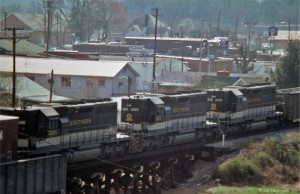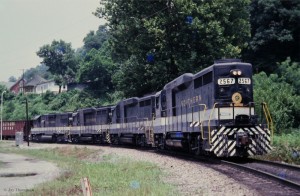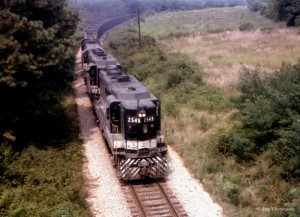
Track Plans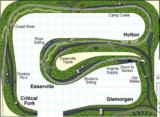 Southern Track Plans Southern Track Plans Interstate Track Plans Interstate Track Plans |
Photos | Models |
History
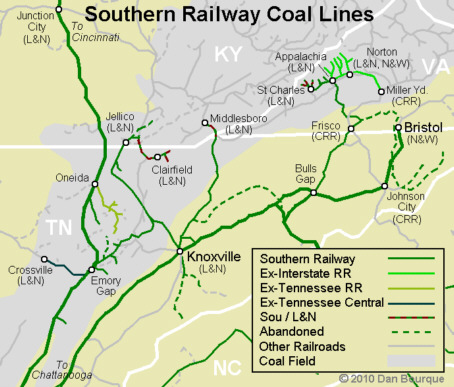 The Southern Railway was one of the giants of 20th century railroading. The Southern formally became a railroad in 1894, and over the next 90 years would blanket the southeast through nearly 150 mergers and acquisitions. The Southern’s mainline through the coal fields was the ex-Cincinnati, New Orleans & Texas Pacific (CNO&TP) mainline from New Orleans, Louisiana to Cincinnati, Ohio, known as the “Rathole” for its tunnels, cuts and bridges through Tennessee and Kentucky. The Southern’s early Appalachian coal field lines (in addition to some coal lines in Alabama) were shared with the Louisville & Nashville including the Clairfield Branch in Tennessee (reached via a branch to Jellico, KY), a few mines on L&N tracks around Middlesboro, KY, and the Southern’s own St. Charles Branch in Virginia also served by the L&N out of Pennington, VA. The Southern also hauled a lot of the coal tonnage brought in by smaller railroads such as the Tennessee Railroad, Tennessee Central and the Interstate Railroad. Eventually, the Southern acquired all three of these roads. It bought the Interstate Railroad in 1960 and the Tennessee in 1974, and it bought parts of the Tennessee Central in 1968 (the L&N bought the rest). These new lines, especially the Interstate, made the Southern a respectable Appalachian coal hauler.
The Southern Railway was one of the giants of 20th century railroading. The Southern formally became a railroad in 1894, and over the next 90 years would blanket the southeast through nearly 150 mergers and acquisitions. The Southern’s mainline through the coal fields was the ex-Cincinnati, New Orleans & Texas Pacific (CNO&TP) mainline from New Orleans, Louisiana to Cincinnati, Ohio, known as the “Rathole” for its tunnels, cuts and bridges through Tennessee and Kentucky. The Southern’s early Appalachian coal field lines (in addition to some coal lines in Alabama) were shared with the Louisville & Nashville including the Clairfield Branch in Tennessee (reached via a branch to Jellico, KY), a few mines on L&N tracks around Middlesboro, KY, and the Southern’s own St. Charles Branch in Virginia also served by the L&N out of Pennington, VA. The Southern also hauled a lot of the coal tonnage brought in by smaller railroads such as the Tennessee Railroad, Tennessee Central and the Interstate Railroad. Eventually, the Southern acquired all three of these roads. It bought the Interstate Railroad in 1960 and the Tennessee in 1974, and it bought parts of the Tennessee Central in 1968 (the L&N bought the rest). These new lines, especially the Interstate, made the Southern a respectable Appalachian coal hauler.
Throughout its history, the Southern was known for innovation. It became the first Class I railroad to completely dieselize in 1953, and it was always testing ideas ahead of their time, many of which revolved around coal including 100 ton hoppers, rapid discharge cars, and radio-controlled mid-train helpers and even the unit coal train. The Southern was also known for safety and was the last major railroad to order its locomotives with high-short hoods and run them long-hood forward, a characteristic shared with the Norfolk & Western with which the Southern merged in 1982 to create the Norfolk Southern. The Southern’s coal fields in Virginia were eventually merged with the N&Ws to expand the enormous Pocahontas Division of the NS.
Coal Lines and Operations
The Southern’s coal operations were scattered throughout the southern Appalacians and included lines in Virginia (Appalachia Division and the Interstate), Kentucky (Middlesboro) and Tennessee (the Tennessee Railroad, Brimstone and Clairfield Branch).
Appalachia District and the Interstate. The majority of the Southern’s coal tonnage in the Appalachians flowed through Appalachia, Virgina. This was home to the yard used to serve the loaders on the St. Charles Branches and a connection with the L&N and Interstate. In 1960, the Southern acquired the Interstate, but operations remained relatively unchanged until the Southern closed its yard in Appalachia and moved into the Interstate’s yard at Andover, VA in July 1965. Soon thereafter, the Interstate’s colorful cream, orange and gray RS3 were scattered to yards throughout the south (they couldn’t MU with the Southern’s diesels), and the Southern brought in worn-out F-units to replace them. Westmoreland Coal Company soon built a giant transloader on top of the Southern’s old yard, and much of the Southern’s work in this area consisted of gathering coal from the nearby branches (St. Charles Branch and the Interstate’s Roda, Roaring Fork, Pardee, Dorchester, Dixiana and Glamorgan Branches) in old twin hoppers (known as “yellow balls” to crews because of the big yellow dots painted on their sides) and dropping them off at the transloader. From there, large unit trains of 100 ton hoppers or the signature Southern “silverside” gondolas would load and take the coal south through Frisco and Bulls Gap using newer 6-axle power and radio controlled mid-train helpers to serve hungry power plants in the South. Unit trains also loaded north of Andover at the large Wentz prep plant and later at Ramsey, east of Norton. The N&W also supplied (and took) coal from the connection with the former Interstate at Norton, VA. The Southern had a connection with the Clinchfield via Miller Yard, but after 1973 when the L&N gained trackage rights over the N&W to reach the Clinchfield, this line was only used for a few plate-C or larger cars which wouldn’t fit through the N&W’s tight tunnels. The trackage east of Ramsey was eventually abandoned in the 80s. In the 70s, the F-units and GP7s were eventually replaced with newer 4-axle geeps (mainly GP38s), and the small yard at St. Charles, VA was opened up as a mine run base, but by and large.By and large, the pattern of operation established in 1973 stayed in place until the NS merger.
Middlesboro. The Southern’s connected to Middlesboro, KY from Knoxville, TN via the old Knoxville, Cumberland Gap and Louisville Railroad which it bought in 1896. It sold the Cumberland Gap tunnel to the L&N for their original Cumberland Valley mainline (until then, the L&N had leased it from the KCG&L) but retained trackage rights into the area where it picked up coal from the L&N’s nearby “Middlesborough Railroad” branch to Capito, KY and Manring, TN. While some maps list this branch as joint trackage, it appears the L&N worked the tipples (only every other day during the 60s), and the Southern merely picked up the coal and perhaps some light non-coal traffic at the L&N’s Middlesboro Yard for transportation to Knoxville and beyond. The smaller loaders were later replaced by two large loaders on the branch which appears to have led the NS to continue its trackage rights agreements into Middlesboro.
Clairfield. The Southern and L&N both served the Clairfield Branch on the Tennessee/Kentucky border. The branch spurred off the L&N’s Corbin, KY to Knoxville, TN mainline near Morley, TN, and the Southern reached the branch via trackage rights from its connection at Lot, KY (near Jellico). The Clairfield Branch was a sleepy little branch which reached as far as Fonde, KY, but like most coal branches in the area, it saw a resurgence during the coal boom of the 1970s. Southern mine runs originated out of the small yard at Jellico.
Tennessee Railroad. The Tennessee Railroad was essentially a long branchline that ran south from its yard and connection with the Southern’s mainline at Oneida, TN. The branch ran down Paint Rock Creek and then up the New River to its headwaters near Fork Mountain (about 30 miles). This dual grade meant the coal would have to be hauled upgrade into Oneida. There were numerous short branches serving mines, but most were abandoned before the Southern takeover in 1973.
Other coal lines in Tennessee included the Brimstone Railroad which connected with the Southern’s mainline at Phillips, TN (just south of Oneida) and the Harriman and Northeastern which connected with the Southern’s mainline at DeArmond, TN and served mines across the ridge from the Tennessee Railroad until the Southern abandoned it. The Southern also acquired several miles of the Tennessee Central in 1968, but most of the coal operations along the TC had already ceased by this time.
Related Products:
Sources:
- “Bought by the Southern” New York Times, 10 Apr 1973
- Wolfe, Ed The Interstate Railroad: Old Line Graphics
- Flanary, Ron L&N Cumberland Valley Division Album 1945-1985: Old Line Graphics
- Flanary, Ron Louisville and Nashville in the Appalachians: Old Line Graphics
For related information, see the Interstate Railroad and NS pages




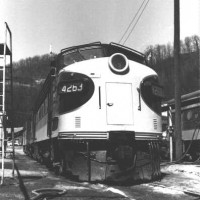 Southern Photos Page
Southern Photos Page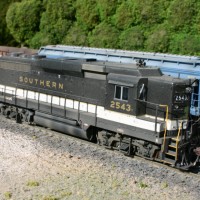 Southern Models Page
Southern Models Page